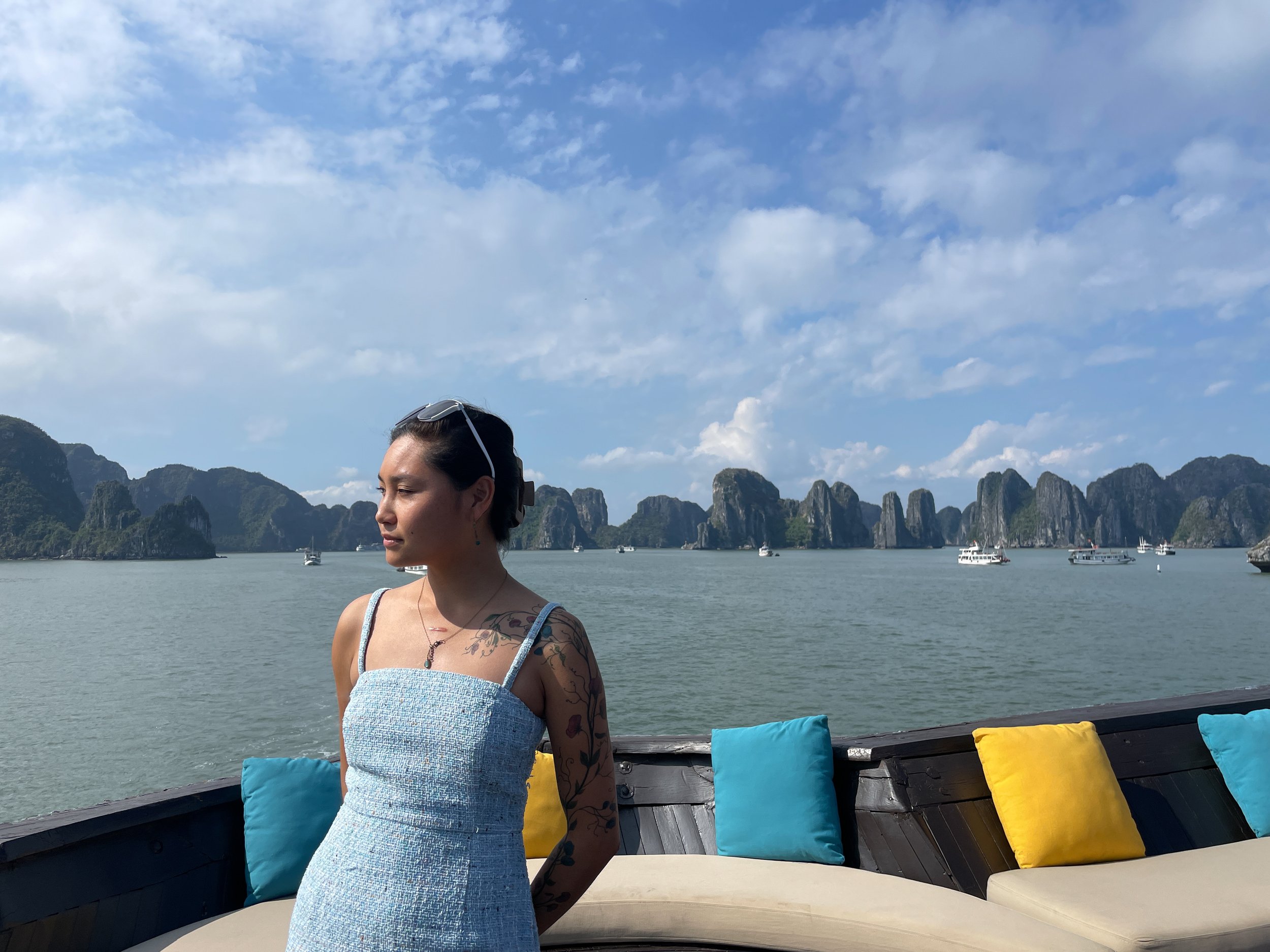Land of the Descending Dragon and the Ever-Changing Sky
how Ha Long Bay resonated with me the most on my VN expedition
November 2024, written and published Jan 7, 2025
The myth of these islands tell a story of a descending dragon spitting fireballs in order to protect inhabitants from invaders. The spit resulted in pearls that arose from underneath the sea to form a tricky barricade in the South China Sea. Other legends have it that the rocks resemble the back scales of a dragon slinking into the waters.
In my novel idea, I crafted a story of a shaman who resided on one of the floating villages of the islands of Ha Long Bay. It is not his story, but it’s about a young girl who was born on these islands after a profound miraculous birth accompanied by the spiritual shaman. I admit that it is a dramatization of my own birth. Being born between two brothers who died at birth and being told by the doctor that I wouldn’t live, I defied odds the second I came into this world. I pictured myself in a place untouched by the perils of war accompanied by good spirits and nature.
Being born a Texan coastal plains girl that knew nothing of mountains and elevations until my twenties, I had only brief glimpses of these images in our family’s one-stop shop in Houston’s Chinatown of Hong Kong City Mall market, where these mountains glossed on light-boxes for wall displays, nightlights, and various hand-painted traditional fabrics and toys. I had no idea that Vietnam was so mountainous. It was a faraway dreamland, and my parents rarely ever spoke of it due to them not experiencing them themselves.
These mountains were foreign. As I passed between the large boulders on a cruise ship with the red flag with yellow star waving in the wind, I feel somewhat connected and overtaken. I felt a feeling of loss. Prior to my visit, I visited a museum that confirmed my ancestral roots in this region. Knowing this fact alone tethered my heart to the Vietnamese Northern province.
It was not the old folks from the mountains in the North and North West of Viet Nam that carried sticks on their backs for kilometers. It was not the children barely 5 years old who did the same and squatted without pants to defecate. It was not the wrinkly smiles of the grandmas that moved me more than the mountains themselves. It was not the amount of sun and wind it took to carve out those crinkles on the cliffs and smile creases. It was the story of my bloodline.
My sister-in-law, Lucie, brought us to the Quang Ninh province museum where I found efforts of preservation that recognized my ancestry. At the entrance, a large wooden boat made of bamboo and masts occupied the lobby. To the side, a laminated poster read the name “Tra Co,” which stuck out to me. My mind recalled a memory when I had once bookmarked a place on Google Maps one silent evening, as I asked my parents where they are from.
Only from word-of-mouth, I knew that my mother’s family resided in the North. However, there it was: the evidence that proved my mother’s tongue true. The Southern town that I had visited years ago for my brother’s wedding was “Tra Co.” The joyful feeling of knowing a place and having visited before, then tracing it back to another place gave me a sense of pride. My ancestors must have missed their homes so much that they gave a Southern town the same name from the North.
I buzzed with curious questions and followed my mom around the museum.
“Here,” she pointed out, “is the type of tool Bac Hai, your eldest aunt, used to use to shuck oysters.”
“This is the type of double-masted boat that uncle and grandpa used to escape war.”
“These are the types of fishing nets we used back then.”
I never had the chance to connect with my mom like this, as pieces of her childhood do not exist in American museums. But here, in glass entombed cases with Vietnamese descriptions, I peered at a past that spoke of my mother’s background. The fish baskets, bamboo tools, and plain style clothing were evidence of lives that endured suffering, famine, and backbreaking labor in the last century.
Life is ironic in many ways. I thought about their past struggles while taking a leisurely cruise through the bay. We ate a lavish buffet with a tiered shrimp cake with dazzlers and sunbathed in our private rooms with balconies. The weather at the time was inviting, giving me the illusion of paradise. The many shades of emerald greens in tones of saturation levels of the mountains in the bay deluded and beckoned me. Is it true? That this was once my ancestors’ home? I would love to believe if I could have been once that young girl born on these islands.
Whatever the legends, I found the beauty breathtaking, enlivening, and I conclude that if I were a dragon, too, that I would also blow fiery breaths to protect the land.





